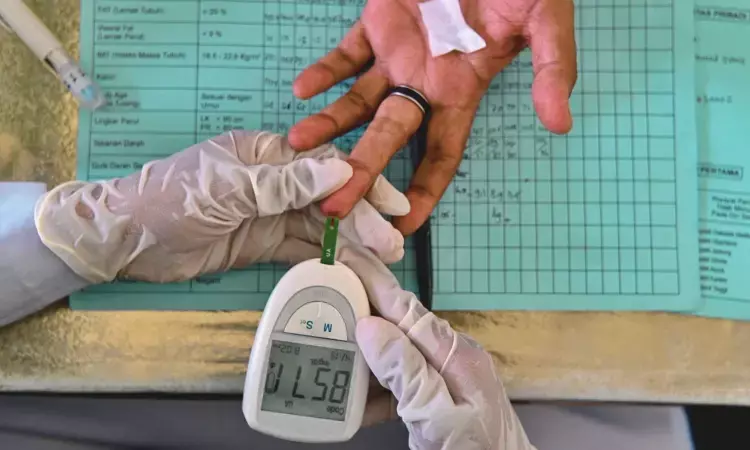- Home
- Medical news & Guidelines
- Anesthesiology
- Cardiology and CTVS
- Critical Care
- Dentistry
- Dermatology
- Diabetes and Endocrinology
- ENT
- Gastroenterology
- Medicine
- Nephrology
- Neurology
- Obstretics-Gynaecology
- Oncology
- Ophthalmology
- Orthopaedics
- Pediatrics-Neonatology
- Psychiatry
- Pulmonology
- Radiology
- Surgery
- Urology
- Laboratory Medicine
- Diet
- Nursing
- Paramedical
- Physiotherapy
- Health news
- Fact Check
- Bone Health Fact Check
- Brain Health Fact Check
- Cancer Related Fact Check
- Child Care Fact Check
- Dental and oral health fact check
- Diabetes and metabolic health fact check
- Diet and Nutrition Fact Check
- Eye and ENT Care Fact Check
- Fitness fact check
- Gut health fact check
- Heart health fact check
- Kidney health fact check
- Medical education fact check
- Men's health fact check
- Respiratory fact check
- Skin and hair care fact check
- Vaccine and Immunization fact check
- Women's health fact check
- AYUSH
- State News
- Andaman and Nicobar Islands
- Andhra Pradesh
- Arunachal Pradesh
- Assam
- Bihar
- Chandigarh
- Chattisgarh
- Dadra and Nagar Haveli
- Daman and Diu
- Delhi
- Goa
- Gujarat
- Haryana
- Himachal Pradesh
- Jammu & Kashmir
- Jharkhand
- Karnataka
- Kerala
- Ladakh
- Lakshadweep
- Madhya Pradesh
- Maharashtra
- Manipur
- Meghalaya
- Mizoram
- Nagaland
- Odisha
- Puducherry
- Punjab
- Rajasthan
- Sikkim
- Tamil Nadu
- Telangana
- Tripura
- Uttar Pradesh
- Uttrakhand
- West Bengal
- Medical Education
- Industry
Diabetes Incidence Surges 62 Percent in India: Study Highlights Alarming Rise, Regional Gaps, and Future Burden

India: India is facing a rapidly escalating diabetes crisis, with significant state-wise differences in disease burden and projections indicating an even steeper rise by 2031, according to a new study based on data from the Global Burden of Disease (GBD) Study 1990–2021. The findings were published online in Frontiers in Endocrinology on 12 May 2025.
The analysis offers a comprehensive look at the trends in diabetes incidence, prevalence, mortality, and Disability-Adjusted Life Years (DALYs) across the country. Using data from the GBD database, Shubham Chauhan, Evidence for Policy and Learning, Global Center for Evidence Synthesis, Chandigarh, India, and colleagues evaluated long-term trends and utilized ARIMA (Autoregressive Integrated Moving Average) models to forecast the trajectory of the disease over the next decade. Their findings raise serious concerns for public health, especially in southern and western Indian states.
The key findings were as follows:
- Between 1990 and 2021, the age-standardized incidence of diabetes in India increased from 162.74 to 264.53 cases per 100,000 population.
- The overall annual percentage change (APC) in diabetes incidence during this period was 0.63%.
- Notable spikes in incidence were observed during 1996–1999 and 2005–2011, with APCs of 2.25% and 2.07%, respectively.
- The age-standardized mortality rate due to diabetes rose from 23.09 to 31.12 per 100,000 population between 1990 and 2021.
- States such as Tamil Nadu, Goa, and Karnataka reported the highest DALYs related to diabetes.
- By 2031, the prevalence of diabetes in India is projected to reach 8585.45 per 100,000 population.
- DALYs are forecasted to exceed 1241.57 per 100,000 by 2031, highlighting a growing burden on the healthcare system.
The authors highlighted that this trend is being driven largely by modifiable risk factors such as poor dietary habits, increasing levels of physical inactivity, and rising body mass index (BMI)—issues that are especially concerning in high-burden states. They emphasized that effective management of diabetes will require state-specific public health strategies that go beyond a one-size-fits-all approach.
In light of these insights, the study calls for a two-pronged strategy. At the primary prevention level, promoting healthier lifestyles through widespread community-based education, dietary guidance, and structured physical activity initiatives is key. Simultaneously, secondary prevention should involve robust screening systems and timely medical interventions aimed at early detection and control of the disease.
The authors caution that while GBD data offer valuable national and regional perspectives, the modeled estimates may not capture all the nuances of local disease patterns. Nevertheless, the findings provide essential evidence to guide policymakers in prioritizing resources and designing tailored interventions to combat the growing diabetes epidemic.
Reference:
Chauhan, S., Khatib, M. N., Ballal, S., Bansal, P., Bhopte, K., Gaidhane, A. M., Tomar, B. S., Ashraf, A., Kumar, M. R., Chauhan, A. S., Shabil, M., Jena, D., Bushi, G., Satapathy, P., Jain, L., Jaiswal, V., & Pant, M. (2025). The rising burden of diabetes and state-wise variations in India: Insights from the Global Burden of Disease Study 1990–2021 and projections to 2031. Frontiers in Endocrinology, 16, 1505143. https://doi.org/10.3389/fendo.2025.1505143
Dr Kamal Kant Kohli-MBBS, DTCD- a chest specialist with more than 30 years of practice and a flair for writing clinical articles, Dr Kamal Kant Kohli joined Medical Dialogues as a Chief Editor of Medical News. Besides writing articles, as an editor, he proofreads and verifies all the medical content published on Medical Dialogues including those coming from journals, studies,medical conferences,guidelines etc. Email: drkohli@medicaldialogues.in. Contact no. 011-43720751


